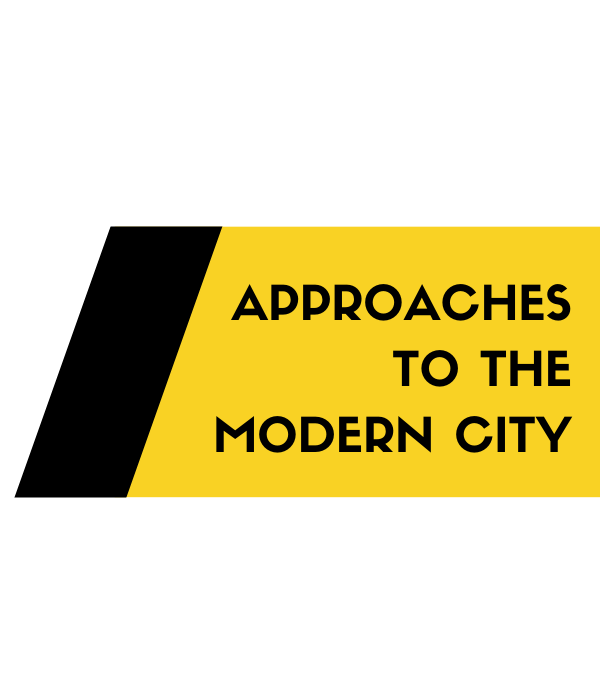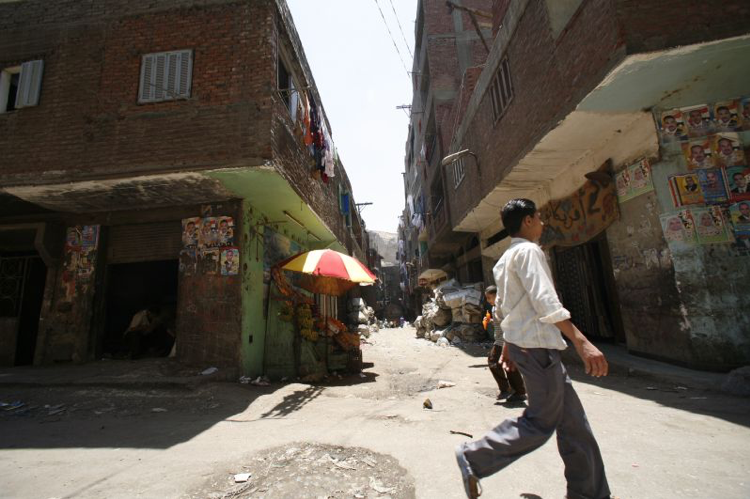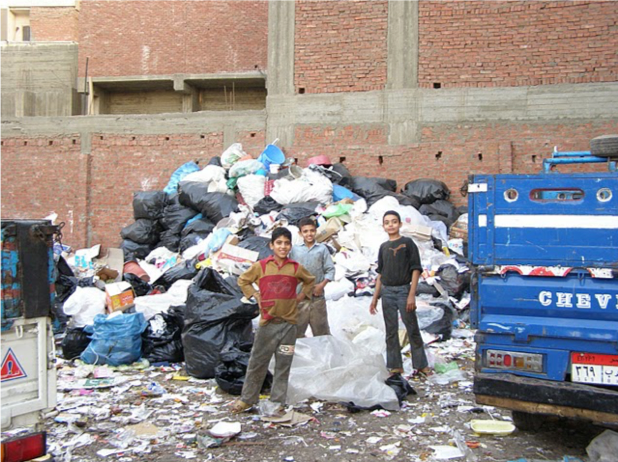By Rosalie Lovy
Questions
What are the pros and cons of public waste management (vs privatized)? What are the different elements of the waste management industry? In Cairo, how has modern growth changed waste infrastructure? What cultural/social aspects of the Zabbaleen community contribute to its economic activity? How do the interests of the Zabbaleen intersect with the interests of the city as a whole?
Discussion
The relationship between Cairo and its trash collectors, the Zabbaleen, is at once symbiotic and toxic.
The Zabbaleen settled in Cairo in the 1930s after leaving Southern Egypt. The initial population consisted of Christian pig farmers who were interested in purchasing domestic waste as inexpensive feed for their pigs (Kingsley and El-Hakim, 1979). A different group, the Wahiya, who arrived in Cairo decades before the Zabbaleen, owned the rights to much of the city’s domestic waste based on contracts they had established with building owners. The Wahiya sold the waste to bathhouses as fuel for their water heaters. When the Zabbaleen arrived, they initially only rented rights to the waste from the Wahiya in order to feed their pigs. Over time, this relationship evolved into one in which the Zabbaleen continued to raise pigs while also performing the waste collection as well as sorting the material for recycling. The Wahiya continued to own and manage the contracts with building owners, collecting payments from the Zabbaleen for the right to the garbage. (Fahmi and Sutton, 2013).
The Zabbaleen came to Cairo as a tight-knit group of Coptic Christians, and this continues to describe the population today. The religious separation from mainstream Cairo has helped them to remain united yet has also contributed to their endemic marginalization (El-Hakim, 1977). The unsavoriness of their profession, which forces the Zabbaleen to live among massive amounts of domestic waste, further contributes to their negative social identity. These mountains of trash as well as the pigs necessary to the Zabbaleen’s livelihood has made them unpopular neighbors and very easy to evict (Miller, 1990). The emphasis on family structures has encouraged marriage within the community and thus made strong community bonds with other groups in Cairo more difficult to solidify (El-Hakim, 1977). This isolated social identity has resulted in their systematic relocation further and further from main districts and the garbage they collect as well as municipal services (Fahmi and Sutton, 2013). This affects their access to utilities as well as emergency aid such as fire rescue and ambulance service. It also makes the trash more difficult to collect. (Woods, 2011).
When the government regulated the rights to garbage collecting in the 1980s, they left out the Zabbaleen from the legal contracts, only addressing the Wahiya (Didero, 2012). After this regulation process, the Wahiya were forced to pay taxes on their contracts but could legally inherit waste rights as they had done previously. This regulation also afforded some legal protections to the Wahiya. Such protections were not extended to the Zabbaleen, whose livelihood remains unofficial and unprotected.
In spite of this legal status, the recycling activities of the Zabbaleen support many manufacturing processes within Greater Cairo as well as large-scale supply chains involving international manufacturing powerhouses such as China. Beginning in the 1990s, the Chinese have purchased processed plastic chips from Egypt for textile production. Egypt is only one of many sources for this material, so the ability to enter into this market is reliant on meeting the Chinese buyers’ quality standards with little control over pricing (Woods, 2011). Within Cairo, a valuable good found in household waste is aluminum, which can be melted for the production of metal housewares by local manufacturers. In fact, by some estimates, the Zabbaleen have succeeded in recycling 80% of Cairo’s household waste (Fahmi and Sutton, 2013). The Zabbaleen’s use of the remaining refuse as pig fodder is extremely cost-efficient and has allowed them to enjoy relatively sizable incomes compared to other impoverished groups in Cairo (Miller, 1990).
In addition, the close-knit social structure of the community has provided internal resources for education and business apprenticeships which help to fill the gaps left by inadequate access to such resources. The Zabbaleen, due to their arduous work, social marginalization, and physical distance from public services, have low school attendance rates. However, younger generations are beginning to seek more advanced education as their business becomes more complex and interacts with a more diverse set of contacts. The Recycling School, for example, is aided by an international NGO to educate members of the Zabbaleen community who wish to continue their education at any age. Projects such as this are necessary given the difficulty in accessing mainstream education as well as the need to balance work with the effort to study. (Woods, 2011). Trainings in various aspects of the recycling economy can also be invaluable in sustaining long-term solvency for family groups threatened by changing economic circumstances. For example, a pig farmer might train part of his family in recycling or aluminum processing to protect against possible downturns in other parts of the family business (Woods, 2011).
The Zabbaleen are especially vulnerable to a volatile income stream given their uncertain legal status. Since the Zabbaleen’s settlements on the periphery of Cairo are not legally developed, not only are their settlements easily relocated but their stores of waste are not protected from government seizure. An example of this is the 2009 Swine Flu epidemic which prompted the Egyptian government to mandate the slaughter of most of the pigs in Egypt. These pigs constituted an integral element of the Zabbaleen economy, and their absence has both reduced the income of the pig farming community as well as the overall capacity for garbage processing, since the pigs consume the waste. Combined with the massive increase in number of households in Cairo as well as growth in the amount of waste produced by each household, this loss of pigs has resulted in overwhelming backlogs of waste that the Zabbaleen are unable to process (Fahmi and Sutton, 2013).
Government efforts to modernize the system of waste collection have threatened the Zabbaleen since the 1970s. The government’s proposed solutions to the perceived problem of excess waste at this time include the implementation of new technologies for waste collection and the contracting of international companies to replace the Zabbaleen. This was intended both to reduce the amount of unsightly trash in the city as well as to improve the Zabbaleen’s quality of life. Kingsley and El-Hakim argue that in the case of Cairo, modernizing trash collection is actually less efficient than the current system, which provides employment and income to the Zabbaleen (Kinglsey and El-Hakim, 1979). While the business of trash collecting is unhygienic and difficult, it is also a reliable source of employment that the government would not be able to replace.
In the 21st century, conservationists have made objections to the unsightly garbage trucks in historic areas. In particular, recent efforts to protect the old medieval parts of the city have hampered the daily activities of garbage collectors (Didero, 2012). The growing tourist industry that motivates these conservation efforts is also contributing significantly to the problem of trash in Cairo. Hotels produce massive amounts of waste, much of which is recyclable. The inability of hotels to meet benchmarks for waste reduction within Cairo is an example of the ever-increasing burden of excess waste faced by the city today. This problem was predicted by Kingsley and el-Hakim in 1979, who criticized US policies for waste reduction as impossible to implement in a timely manner (Kingsley and El-Hakim, 1979). The environmental impact of these luxury hotels is significant and has progressed unchecked in spite of government calls for reduced waste production. (Ball and Taleb, 2001) Since the arrival of the Wahiya in the early 1900s, buildings serving high-income tenants such as hotels and luxury apartment buildings have been valued more highly than other buildings, a difference which is reflected in the prices charged to the Wahiya for the right to the trash. (Kingsley and El-Hakim, 1979).
Reliance on the Zabbaleen has also resulted in general pushback on government initiatives to hire international contractors for garbage collection. This is evidenced by the failure of foreign contractors to replace the Zabbaleen even when granted government contracts. New garbage trucks were unable to navigate the narrow streets and many residents prefer the personal service style of the Zabbaleen, who collect trash door-to-door and have long-standing relationships with their clients (Fahmi and Sutton, 2013).
Overall, the question of how to improve the lives of the Zabbaleen is complicated by the contradiction between the humanitarian urge to improve their hygiene and opportunities and the need for efficient waste disposal for an exploding urban population. On one hand, the Zabbaleen have sustained themselves through their unregulated economic activities and have provided valuable services to the city, both through garbage collection and through the processing of low-cost recycled goods and materials. However, the Zabbaleen’s illegal professional and residential status subject them to civil injustices and a deplorable standard of living.
Sources
Ball, Stephen, And Mohamed Abou Taleb. “Benchmarking Waste Disposal in the Egyptian Hotel Industry.” Tourism and Hospitality Research 11, No. 1 (2011): 1-18.
Didero, Maike. “Cairo’s Informal Waste Collectors: A Multi-Scale and Conflict Sensitive Perspective on Sustainable Livelihoods.” Erdkunde 66, No. 1 (2012): 27-44.
El-Hakim, Shérif Mahmoud. “The Role of The Family, Kinship and Rural / Urban Migration in The Processing of Solid Waste in Cairo.” Africa Development / Afrique Et Développement 2, No. 2 (1977): 115-23.
Fahmi, Wael, And Keith Sutton. “Cairo’s Contested Waste: The Zabbaleen’s Local Practices and Privatisation Policies.” In Organising Waste in The City: International Perspectives on Narratives and Practices, Edited by Campos María José Zapata And Hall C. Michael, 159-80. Bristol, Uk; Chicago, Il: Bristol University Press, 2013.
Haynes, Kingsley E., And Sherif M. El-Hakim. “Appropriate Technology and Public Policy: The Urban Waste Management System in Cairo.” Geographical Review 69, No. 1 (1979): 101-08.
Miller, Robert L. “Hogs and Hygiene.” The Journal of Egyptian Archaeology 76 (1990): 125-40.
Woods, Elliott D. “Garbage City: For Cairo’s Coptic Christians, The Future May Rise from What Others Discard.” The Virginia Quarterly Review 87, No. 2 (2011): 4-27.



